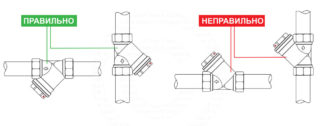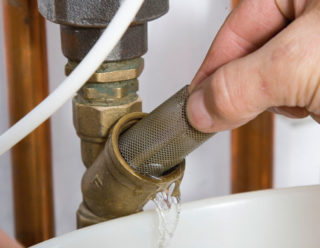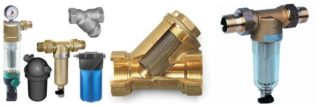The water that flows from the taps in our apartments can be of questionable quality. It contains many elements that may not have the best effect on human health. That is why the installation of a coarse water filter is a very useful condition these days. These devices reliably protect the water supply from solid elements in the composition of water, so sometimes they themselves need to be cleaned.
Coarse filter device
Each filter has a dedicated outlet. This prevents the system from clogging up with debris. Such taps are called mud collectors. To prolong the life of the filter, the sump must be cleaned regularly.
Outwardly, the filter resembles a tee. The difference is that the outlet of this device is deaf and sealed, closed with a threaded lid. A cylinder-shaped mesh is attached inside. The center line of the grid has a common axis with an outlet in the body.
So that the debris collected inside the purifier does not interfere with the movement of water for as long as possible, the body should be oriented so that the mesh is vertical or at an angle, but not flat. In this case, the entrance to the grid itself should be higher - due to this, debris accumulates on the other side of it.
To clean the filter, you need to unscrew the plug and remove the flushing mesh, and then put it back in place. There are also devices on the market that can be cleaned without disassembling. In this case, the plug is replaced by a branch pipe, and a hose is already connected to it and lowered into the sewer. On the inside of the mesh compartment, water is pumped and flows directly into the sewer drain, and with it all the dirt.
Where is the filter installed and what is it for
- detains large debris;
- does not allow waste to spoil the meter impeller and clog its protective walls;
- protects mixer valves.
It is worth noting that the coarse filter does not prevent the penetration of fine sand or silt, but it will definitely not miss scale, large fragments and rusty deposits. And there are always enough of these harmful elements on the walls of water pipes.
Many owners, when installing a water meter, immediately install a filter. So they can be sealed at the same time, which will avoid cheating the meter readings. For this, special filters are used, the plug of which has an eyelet. A wire of the seal is threaded through it, and it will be strictly forbidden to tear it off personally - a call from the master will be required.
How the filters are cleaned
Today, mainly mechanical filters for coarse water purification are used. Their varieties will be discussed further.
Devices are divided into:
- mesh (angular, straight, straight-through);
- cartridge.
All strainers have a similar design and are cleaned in the same way. Inside such devices there is a filter mesh that catches large particles of debris from the water. The device is cleaned through the dirt collector outlet.
Cleaning the strainer
- Before starting to clean the strainer, you need to turn off the water and make sure that it does not leak.
- Using a wrench, unscrew the drain on the sump. A key for 19 or 22 should fit, if not, we use an adjustable one.
- There is a gasket in the sump cover. We need to check her condition, she may need a replacement.
- Next, you pull out the main part of the device - a metal mesh. Even if it is partially contaminated, the water pressure can be significantly impaired.
- We rinse the mesh under a good pressure of water, and clean the clogged holes with an old toothbrush. Experts advise using a short, soft metal bristle brush to remove sludge. We also do not forget to clean the mud sump thoroughly.
- In the reverse order, we assemble the filter into the working position. First, we insert the mesh into the sump, put the gasket, insert the device into the outlet and tighten the lid. After turning on the water, check that there are no drops on the filter.
Above, the scheme for cleaning non-flush mesh filters is considered. However, there are also self-cleaning ones. Such filters have an automated system that, without human intervention, removes contaminants after a signal that is sent as the mesh becomes dirty.
Cleaning the cartridge filter
The system is installed in places where mesh filters cannot cope with dirt. Cartridge filters retain finer debris than mesh filters.
To clean it from accumulated dirt, you need to do the following:
- we shut off the water;
- we substitute a certain container under the filter, since dirty liquid can pour out of it;
- unscrew the clamping nut with a special wrench;
- we wash the old cartridge under a strong pressure of water or replace it with a new one, if necessary;
- put the flask back and tighten all the nuts, and then tighten them with a wrench.
Winding cartridges are suitable for reusable use. To clean such a part, you will need a very powerful stream of water. The filter is placed vertically on the bottom of the bath, the hose is directed to the center of the cartridge. The pressure of water flushes out all unnecessary things from the device.
Prevention measures against clogging
- The cartridge filter, as mentioned above, can only be cleaned if it is winding. In other cases, cleaning is not required - you just need to change the cassette.
- The frequency of cleaning coarse water filters depends on how intensively you use the water supply system, as well as on the quality of the water supplied to the pipes. Use the readings of the pressure gauges before and after the filter as a guide.
- The frequency of cleaning coarse water filters depends on the intensity of the water supply and the amount of impurities in the flow. The indications of the pressure gauges before and after the filter or the weakening of the pressure from the tap can serve as a reference point.
- It is advisable to repeat the cleaning procedure for prophylaxis once every three months. This will prevent damage to the filter and ensure its best functioning, which in turn will lead to improved water quality in the apartment.













